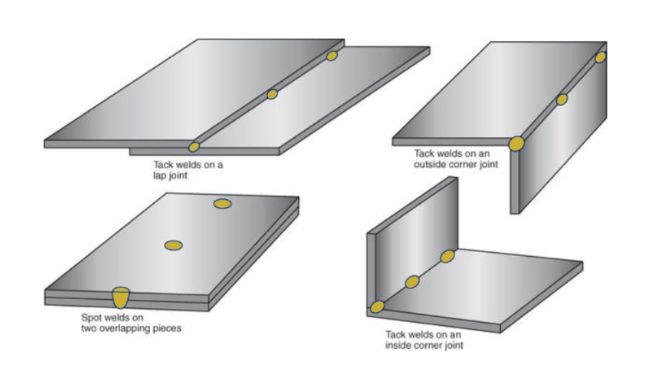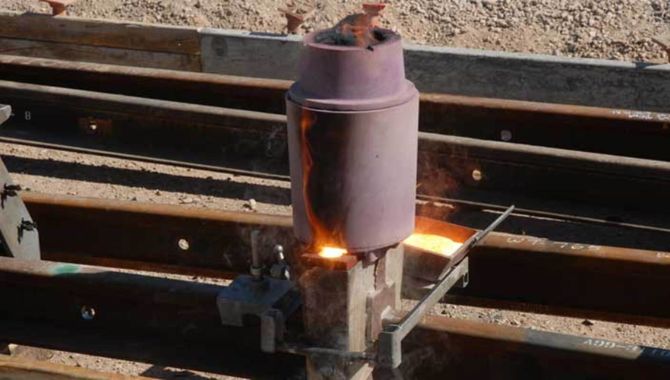Tack Welding Procedure
Welding is a fabrication process for joining two or more pieces of metals or thermoplastic materials. There are several classifications of welding processes. Each type of welding process is suitable for a certain application or project. In this article, we will discover one of its types called tack welding.
This article will help you understand the definition of tack welding, its purpose, significance, methods, and role in ensuring structural integrity. You will also learn about its different applications and how it become vital for successful welds in various industries. So, let’s begin!
What is Tack Welding Meaning?
Tack welding is important in the field of welding and fabrication. This is a preliminary welding process that involves creating a small weld at various joints before the final weld. It is a temporary process that uses very short arc and low heat to weld different metal materials. This welding process is ideal for welding sheet metal process.
The required tack welds in a certain project will depend on its metal type, joint geometry, material thickness, and length. Complex joints require tack welds. Therefore, tack welding should be one of the skills of all welders.


Its Purpose
Tack welding is used for holding workpieces in the correct alignment. It is very important when dealing with complex structures. It prevents the materials from shifting or moving during the final welding process. Therefore, welders do not need to use any fixtures, allowing them to have cost-effective volume production work.
It also helps in reducing metal distortion during the process. Since they are small, tack welds can be removed easily if the workpieces are not properly aligned. Therefore, resulting in a higher quality and stronger weld.
How Does it Work?
Tack welds are usually made from small beads that are spaced out along the workpieces. The method of tack welding is the same process as the final welding. However, it uses smaller machines to apply the small metal beads.
Tack welding process uses a smaller stud or torch and electrode to put small metal dots on the workpiece.


Suitable Materials for Tack Welding
There are several materials that are used for tack welding including:
- Steel
- Stainless Steel
- Aluminum
- Cast Iron
- Copper
- Brass
- Titanium
- Magnesium Alloy
Significance of Tack Welding
Tack welding is generally an important process to achieve a successful final welding process. It provides several advantages including:
- Materials are properly aligned before the final welding
- Allows the welder to save time from repairing or redoing the project
- Holds the workpieces in place securely
- Reduced distortions
- Contributes to high strength of the final weld
- Helps settle the joint gap
- Temporarily maintains the assembly’s mechanical strength
- KDMFAB manufacturer can control the whole production process
- Creates a high precision final project

Challenges to Overcome
Tack welds must be strong enough to firmly hold the workpieces. When the workpieces are turned or moved, it means that the tack welds are defective. If this happens, the joint of the workpieces will tear apart. This may cause potential hazard to the machinery and people.
Since tack welds are preliminary process prior to final welding, they must not compromise the finished weld quality. This can be achieved by preventing spatter, hard spot, crack, arc strikes, and craters to happen during the process.
Quenching and cooling of the materials used in tack welding can also be a challenging part of the process. If not executed properly, the base metal can get damaged. Rapid quenching during the tack welding process may lead to formation of crack-sensitive and brittle microstructures.
Different Types of Tack Welding

This type of tack welds uses mixing of different materials such as:
- Iron oxide powder
- Aluminum powder
- Pure magnesium metal
The mixture of these three materials will result to more than 4000°F temperature.

Bridge tack welds are commonly used for filling the gaps after the fit-up. These gaps are usually result of improper material cutting.
Tack weld should be applied in a sweeping motion to bridge the gaps. Take note that too much weld can get too hot and may fall in the gap.
You can also apply tack welds alternately to each side until the gap’s middle part and eventually both sides are joint together. This bridge tack weld method is commonly used for flux-cored welding or MIG. However, it consumes more time than the other method.

This type of tack weld is used for supporting the final welding process. standard tack welds are often large enough to support the material’s weight. Therefore, preventing it to break. However, it should also not be too large to the point that it cannot be consumed during the final weld. You need to make sure that the tack size and quantity are balanced.

Hot tacking is also used for bridging or closing a metal gap. This process uses hammered excessive filler and heat. The very high heat will cause contraction. You can fill the metal gap while the it cools down.
Forms of Tack Welds
There are four different forms of tack welds including:
- Square
These are the strongest form of tack weld. It is achieved by applying the tack in a square pattern. Square tack weld is commonly used for joining workpieces with a right angle.
- Vertical
The weld tacks are applied from top to bottom of between the metal pieces that will be joined together.
- Right Angle
This tack weld form is used for welding perpendicular workpieces.
- Right Angle Corner
Using right angle corner tack weld allows joining two pieces together at 90 degrees. For example, you are joining metal workpieces with a T-shape.
Ensuring High-Quality Tack Welding
Here are some ways to ensure a high-quality tack weld:
Testing the Metal Piece
It is the most important way to ensure the quality of the tack weld. You can perform this test on a scrap metal. This test will determine how much metal wire filler will be used during the entire welding process and how to lay the parts.
Clean the Filler
Contaminants may lead to improper joining of workpieces, affecting the success of entire welding process. Therefore, it is ideal to clean the metal filler wire to remove oil, debris, rust, and other contaminants.
Hold Things Using a Tape
Hold the parts using a tape to avoid unnecessary movements during the tack welding process. This will eliminate alignment issues that may occur during the process of cooling down. Request tack welding procedure PDF for more information.



